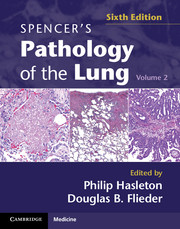Book contents
- Frontmatter
- Dedication
- Contents
- Contents
- Contributors
- Foreword to the First Edition
- Preface to the Sixth Edition
- Acknowledgements
- Chapter 1 The normal lung: histology, embryology, development, aging and function
- Chapter 2 Lung specimen handling and practical considerations
- Chapter 3 Congenital abnormalities and pediatric lung diseases, including neoplasms
- Chapter 4 Pulmonary bacterial infections
- Chapter 5 Pulmonary viral infections
- Chapter 6 Pulmonary mycobacterial infections
- Chapter 7 Pulmonary mycotic infections
- Chapter 8 Pulmonary parasitic infections
- Chapter 9 Acute lung injury
- Chapter 10 Interstitial lung diseases
- Chapter 11 Metabolic and inherited connective tissue disorders involving the lung
- Chapter 12 Hypersensitivity pneumonitis
- Chapter 13 Sarcoidosis
- Chapter 14 Occupational lung disease
- Chapter 15 Eosinophilic lung disease
- Chapter 16 Drug- and therapy-induced lung injury
- Chapter 17 Chronic obstructive pulmonary disease and diseases of the airways
- Chapter 18 Pulmonary vascular pathology
- Chapter 19 Pulmonary vasculitis and pulmonary hemorrhage syndromes
- Chapter 20 The pathology of lung transplantation
- Chapter 21 The lungs in connective tissue disease
- Chapter 22 Benign epithelial neoplasms and tumor-like proliferations of the lung
- Chapter 23 Pulmonary pre-invasive disease
- Chapter 24 Epidemiological and clinical aspects of lung cancer
- Chapter 25 Lung cancer staging
- Chapter 26 Immunohistochemistry in the diagnosis of pulmonary tumors
- Chapter 27 Adenocarcinoma of the lung
- Chapter 28 Squamous cell carcinoma of the lung
- Chapter 29 Large cell carcinoma and adenosquamous carcinoma of the lung
- Chapter 30 Salivary gland neoplasms of the lung
- Chapter 31 Neuroendocrine tumors and other neuroendocrine proliferations of the lung
- Chapter 32 Sarcomatoid carcinomas and variants
- Chapter 33 Mesenchymal and miscellaneous neoplasms
- Chapter 34 Pulmonary lymphoproliferative diseases
- Chapter 35 Metastases involving the lungs
- Chapter 36 Diseases of the pleura
- Index
- References
Chapter 23 - Pulmonary pre-invasive disease
Published online by Cambridge University Press: 05 June 2014
- Frontmatter
- Dedication
- Contents
- Contents
- Contributors
- Foreword to the First Edition
- Preface to the Sixth Edition
- Acknowledgements
- Chapter 1 The normal lung: histology, embryology, development, aging and function
- Chapter 2 Lung specimen handling and practical considerations
- Chapter 3 Congenital abnormalities and pediatric lung diseases, including neoplasms
- Chapter 4 Pulmonary bacterial infections
- Chapter 5 Pulmonary viral infections
- Chapter 6 Pulmonary mycobacterial infections
- Chapter 7 Pulmonary mycotic infections
- Chapter 8 Pulmonary parasitic infections
- Chapter 9 Acute lung injury
- Chapter 10 Interstitial lung diseases
- Chapter 11 Metabolic and inherited connective tissue disorders involving the lung
- Chapter 12 Hypersensitivity pneumonitis
- Chapter 13 Sarcoidosis
- Chapter 14 Occupational lung disease
- Chapter 15 Eosinophilic lung disease
- Chapter 16 Drug- and therapy-induced lung injury
- Chapter 17 Chronic obstructive pulmonary disease and diseases of the airways
- Chapter 18 Pulmonary vascular pathology
- Chapter 19 Pulmonary vasculitis and pulmonary hemorrhage syndromes
- Chapter 20 The pathology of lung transplantation
- Chapter 21 The lungs in connective tissue disease
- Chapter 22 Benign epithelial neoplasms and tumor-like proliferations of the lung
- Chapter 23 Pulmonary pre-invasive disease
- Chapter 24 Epidemiological and clinical aspects of lung cancer
- Chapter 25 Lung cancer staging
- Chapter 26 Immunohistochemistry in the diagnosis of pulmonary tumors
- Chapter 27 Adenocarcinoma of the lung
- Chapter 28 Squamous cell carcinoma of the lung
- Chapter 29 Large cell carcinoma and adenosquamous carcinoma of the lung
- Chapter 30 Salivary gland neoplasms of the lung
- Chapter 31 Neuroendocrine tumors and other neuroendocrine proliferations of the lung
- Chapter 32 Sarcomatoid carcinomas and variants
- Chapter 33 Mesenchymal and miscellaneous neoplasms
- Chapter 34 Pulmonary lymphoproliferative diseases
- Chapter 35 Metastases involving the lungs
- Chapter 36 Diseases of the pleura
- Index
- References
Summary
Introduction
Primary carcinoma of the lung remains globally the most frequent cause of death from malignancy. Although the incidence of this most fatal of diseases is falling in the USA and some western European countries, it is rising in other parts of the world. The enormous increase in tobacco consumption in Asia portends a rise in this disease in those affected countries. Primary lung cancer will be a global problem for many years to come.
As well as a geographic shift in incidence, the most striking demographic change, at least in “Western” populations, has been the decline in lung cancer in males, yet a rise in women. This is almost certainly due to gender differences in smoking habits in previous decades. In addition there has been a shift in the reported incidence of different cell types. In Western populations squamous cell carcinoma and possibly small cell carcinoma (SCLC) have declined, while adenocarcinoma has risen in frequency. While some classification bias may account for a proportion of this change, these shifts have been attributed to changes in smoking habits, changes in cigarettes themselves and, given their apparent greater propensity to develop adenocarcinoma, the increase in the number of women who smoke.
- Type
- Chapter
- Information
- Spencer's Pathology of the Lung , pp. 889 - 944Publisher: Cambridge University PressPrint publication year: 2000
References
- 2
- Cited by



